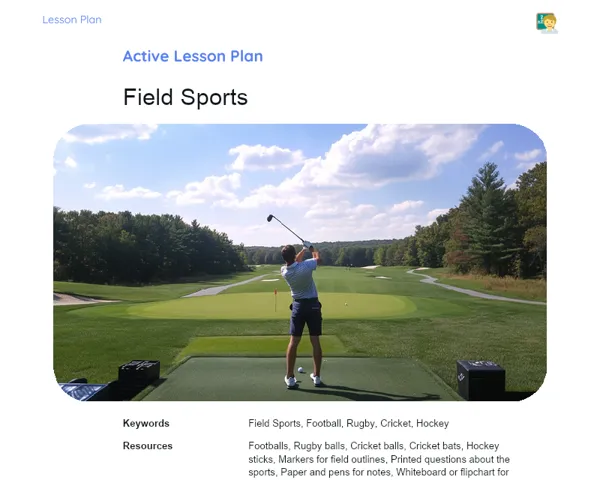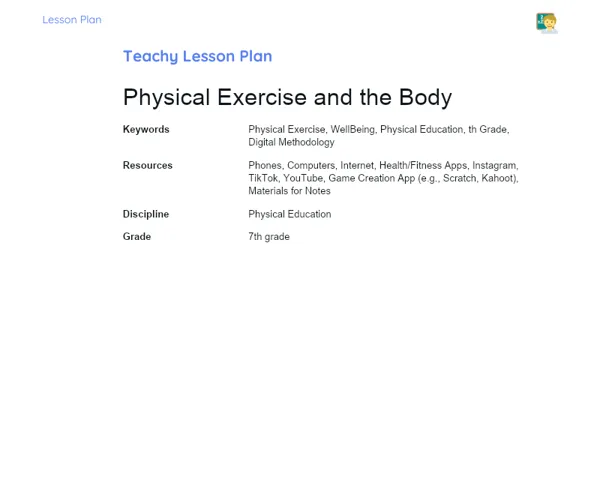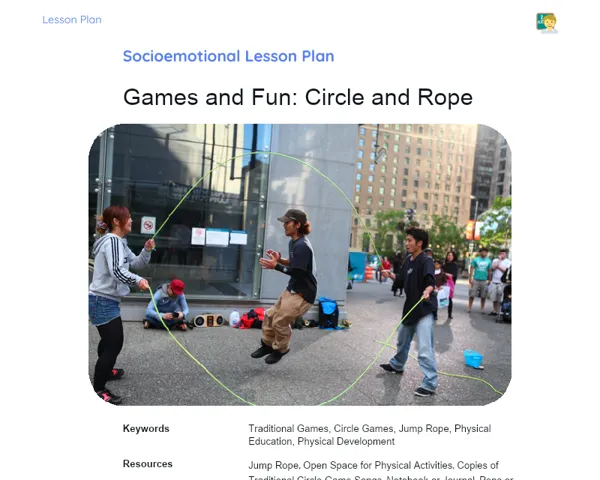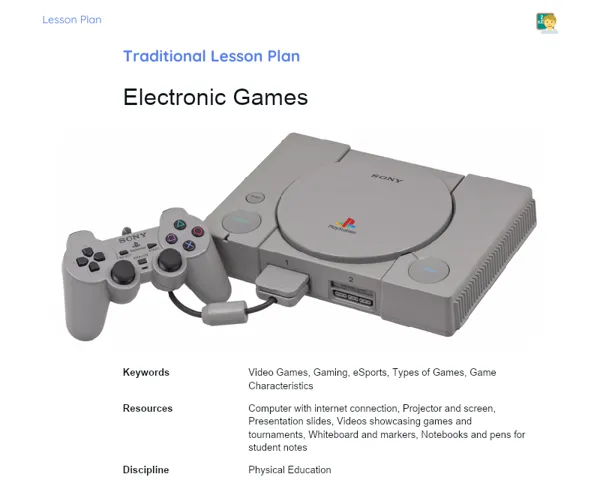Lesson Plan | Active Methodology | Gymnastics
| Keywords | gymnastics, types of gymnastics, physical development, mental development, creativity, practical activity, flexibility, strength, coordination, active learning, flipped classroom, application of knowledge |
| Necessary Materials | large open area for physical activities, gymnastics equipment (mats, ropes, cones, etc.), music for presentations, markers to indicate areas, stopwatch to track time, papers and pens for notes |
Premises: This Active Lesson Plan assumes: a 100-minute class duration, prior student study both with the Book and the beginning of Project development, and that only one activity (among the three suggested) will be chosen to be carried out during the class, as each activity is designed to take up a large part of the available time.
Objective
Duration: (5 - 10 minutes)
Setting clear objectives is essential to guide both the teacher and students on what to focus on during the lesson. It establishes a solid foundation regarding the expected outcomes, ensuring everyone involved is on the same page and ready for the upcoming activities. During this stage, teachers should encourage students to discuss what they have learned at home, helping to enhance their understanding through classroom discussions and practical experiences.
Objective Utama:
1. Empower students to recognize and describe the concept of gymnastics, identifying its types and key features.
2. Explore how engaging in gymnastics contributes to both the physical and mental development of students, particularly those in the fifth grade.
Objective Tambahan:
- Foster active engagement from students through group discussions and hands-on practice of gymnastic movements.
Introduction
Duration: (15 - 20 minutes)
The introduction aims to engage students and bridge the theoretical framework they studied at home with practical, real-life applications. Problem-based scenarios stimulate critical thinking about gymnastics and its relevance, preparing students for a comprehensive understanding during the lesson. By contextualizing gymnastics, students become aware of its importance in everyday life and its historical significance, increasing their interest and motivation to delve deeper into the subject.
Problem-Based Situation
1. Imagine you are an athlete competing in the Olympics and must choose between artistic and rhythmic gymnastics. What factors would influence your decision, and why is gymnastics significant for high-level athletes?
2. Consider a scenario where a group of friends needs to devise a gymnastics routine for a school event. How could they incorporate the principles of flexibility, strength, and coordination to create a captivating yet safe performance?
Contextualization
Gymnastics isn’t just for elite athletes; it plays a vital role in the physical and mental development of individuals across all age groups. In schools, gymnastics aids in enhancing posture, flexibility, and motor coordination while also promoting social skills and self-confidence. Notably, this discipline has a historic lineage that dates back to ancient Greece, where physical training was crucial for soldiers and competitive events. Over the years, gymnastics has evolved into a popular activity in numerous schools and clubs across the globe.
Development
Duration: (65 - 75 minutes)
The development phase is designed for students to apply their gymnastics knowledge in practical, imaginative ways. Through engaging and contextual activities, students get the opportunity to explore various gymnastic aspects—flexibility, strength, and coordination—in an educational and enjoyable manner. This technique reinforces learning, while also fostering teamwork skills, creativity, and critical thinking.
Activity Suggestions
It is recommended that only one of the suggested activities be carried out
Activity 1 - Cirque du Gym
> Duration: (60 - 70 minutes)
- Objective: Encourage students to hone their creativity and motor skills by applying gymnastics concepts in a fun, contextualized manner.
- Description: In this engaging activity, students will formulate small gymnastics routines incorporating flexibility, strength, and coordination elements inspired by circus acts like acrobatics and juggling. Each group will create a presentation that narrates a story through these movements, showcasing their creativity.
- Instructions:
-
Divide the class into groups of up to 5 students.
-
Instruct each group to select a circus theme to base their gymnastics routine.
-
Students should learn and practice basic gymnastics movements, integrating circus elements (like balancing and juggling).
-
Each group must prepare a sequence lasting 1 to 2 minutes that tells a concise story or showcases a unique skill.
-
After the preparation, groups will present their routines, with peers evaluating creativity, technique, and performance.
Activity 2 - Flexibility Olympics
> Duration: (60 - 70 minutes)
- Objective: Encourage flexibility practice in a fun, competitive format, promoting personal growth and teamwork.
- Description: Students will take part in a flexibility challenge, where they need to perform various artistic and rhythmic gymnastics positions. The activity will be organized into different stations, each representing a distinct 'country', where students will tackle flexibility challenges set by the teachers.
- Instructions:
-
Arrange gymnastics stations in various areas of the classroom, each symbolizing a different 'country.'
-
Students, divided into groups, will transition through the stations to attempt the designated flexibility positions.
-
Each group will have a set amount of time at each station to complete the task at hand.
-
Positions might include the bridge, splits, and other fundamental gymnastics poses.
-
Finally, tally the scores from each group, declaring the group with the highest points as the winner.
Activity 3 - Gymnastics Relay
> Duration: (60 - 70 minutes)
- Objective: Help students develop their physical and cognitive abilities in a playful, challenging environment, emphasizing the role of gymnastics in motor skill development.
- Description: This activity transforms the classroom into a gymnastics circuit where students must navigate through various challenges that focus on strength, balance, and coordination. Each circuit station presents a unique challenge involving climbing, jumping, and rotating, and students aim to complete the circuit in the shortest time possible.
- Instructions:
-
Organize a gymnastics circuit within the classroom that includes challenges like rope climbing, jumping over hurdles, and maneuvering around cones.
-
Divide students into groups and explain the operation of the circuit.
-
Each group must traverse the entire circuit as swiftly as they can, covering all stations.
-
Record the time taken by each group.
-
At the conclusion, discuss with students about the strategies used and ways to enhance their gymnastics skills.
Feedback
Duration: (15 - 20 minutes)
The feedback stage serves to solidify learning, allowing students to reflect on the conducted activities and articulate their key takeaways. The group discussion reinforces the understanding of gymnastics concepts, promoting the expression of opinions and active listening. This also provides teachers with an opportunity to gauge students' comprehension and clarify any uncertainties, ensuring that the learning objectives are met.
Group Discussion
At the end of the activities, gather all students for a group reflection. Start by revisiting the lesson objectives and inviting students to share their experiences. Ask how they felt during the activities, what new insights they gained about gymnastics, and how they might apply that knowledge in other contexts. Encourage each group to summarize their routine or share their most memorable moment.
Key Questions
1. What were the biggest challenges you encountered when developing and performing your gymnastics routines?
2. In what ways can gymnastics enhance capabilities like coordination, flexibility, and strength?
3. What insights can you apply from today's activities to improve other areas of life, such as academics or sports?
Conclusion
Duration: (5 - 10 minutes)
The conclusion stage aims to ensure that students grasp and consolidate the content covered during the lesson. This moment is vital for reinforcing learning, connecting theory with practical experiences, and highlighting the topic's relevance in students' lives. Additionally, it helps assess if the learning objectives have been achieved and indicates whether any points require further clarification.
Summary
In this concluding segment, the teacher should recap the main concepts discussed regarding gymnastics, including the definition of the term, key types of gymnastics (artistic, rhythmic, acrobatic, etc.), and their unique characteristics. It’s important to reiterate how gymnastics aids in the physical and mental development of participants, focusing on the benefits of flexibility, strength, and coordination.
Theory Connection
The teacher should emphasize how today's lesson effectively bridged the theoretical knowledge acquired at home with the practical experiences in the classroom. Highlighting the practical activities—like the circus-inspired gymnastics routines, the flexibility challenge, and the gymnastics relay— illustrates the importance of understanding theory for effective practice.
Closing
Finally, the teacher should underscore the importance of gymnastics in students' everyday lives, not just as a sport, but as a means to promote overall health, well-being, and social skills. Stress how gymnastics serves as a versatile tool applicable in various contexts, helping enhance physical skills while nurturing qualities like discipline and teamwork.



